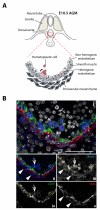A short history of hemogenic endothelium
- PMID: 24095001
- PMCID: PMC4700588
- DOI: 10.1016/j.bcmd.2013.09.005
A short history of hemogenic endothelium
Abstract
Definitive hematopoietic cells are generated de novo during ontogeny from a specialized subset of endothelium, the so-called hemogenic endothelium. In this review we give a brief overview of the identification of hemogenic endothelium, explore its links with the HSC lineage, and summarize recent insights into the nature of hemogenic endothelium and the microenvironmental and intrinsic regulators contributing to its transition into blood. Ultimately, a better understanding of the processes controlling the transition of endothelium into blood will advance the generation and expansion of hematopoietic stem cells for therapeutic purposes.
Keywords: AGM; E; EHT; Endothelial to hematopoietic transition; HSC; HSPC; Hematopoiesis; Hematopoietic stem cell; Hemogenic endothelium; Microenvironment; PAS; aorta-gonad mesonephros; embryonic day; endothelial-to-hematopoietic transition; hematopoietic stem and/or progenitor cells; hematopoietic stem cell; para-aortic splanchnopleura.
© 2013.
Figures


References
-
- Palis J, et al. Development of erythroid and myeloid progenitors in the yolk sac and embryo proper of the mouse. Development. 1999;126(22):5073–84. - PubMed
-
- Ferkowicz MJ, Yoder MC. Blood island formation: longstanding observations and modern interpretations. Exp Hematol. 2005;33(9):1041–7. - PubMed
-
- McGrath K, Palis J. Ontogeny of erythropoiesis in the mammalian embryo. Curr Top Dev Biol. 2008;82:1–22. - PubMed
-
- Medvinsky A, Dzierzak E. Definitive hematopoiesis is autonomously initiated by the AGM region. Cell. 1996;86(6):897–906. - PubMed
-
- Muller AM, et al. Development of hematopoietic stem cell activity in the mouse embryo. Immunity. 1994;1(4):291–301. - PubMed
Publication types
MeSH terms
Substances
Grants and funding
LinkOut - more resources
Full Text Sources
Other Literature Sources

